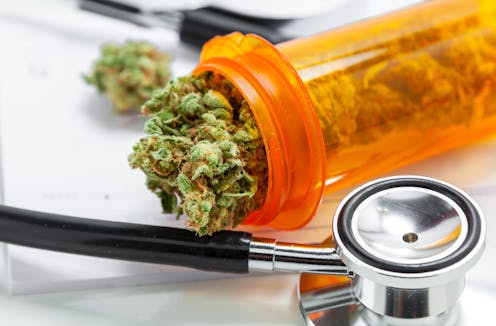Legalising medical marijuana shows no effect on crime rates in US states
- Written by Yu-Wei Luke Chu, Senior Lecturer, Victoria University of Wellington

Those who oppose medical marijuana legislation often cite the strong association between marijuana use and criminal activity. This includes the US federal government, which continues to classify marijuana as a schedule one drug.
We analysed city-level data from states across the US and found that medical marijuana laws have little effect on violent or property crime in nearly all medical marijuana states. In the case of California, the crime rates actually show a substantial decrease of around 20%.
Read more: Medical cannabis users could still be criminalised in UK despite government accepting its benefits
A natural experiment
Medical marijuana laws represent a major change in marijuana policy in the US. Since California passed the first medical marijuana law in 1996, 30 US states and the District of Columbia have legalised medical marijuana.
Several recent studies have found that marijuana use has increased among the general population (including non-patients) in medical marijuana states. It is difficult to disentangle causal effects of marijuana use from spurious correlations because of individual heterogeneity. Individuals who choose to use marijuana are likely different from those who don’t.
The passage of medical marijuana laws offers researchers a good natural experiment to study the causal effects of marijuana use on a variety of health outcomes, including drunk driving, hard drug use and opioid painkiller use.
Users and crime
The perception that marijuana use leads to crime can be traced back to the 1930s. In an effort to gain public support for marijuana prohibition, the Narcotics Bureau chief Harry Anslinger collected dubious anecdotes of marijuana causing crime and violence in his infamous Gore Files.
Read more: Re-criminalizing cannabis is worse than 1930s 'reefer madness'
There is indeed a strong correlation between marijuana use and criminal activity. For example, the Arrestee Drug Abuse Monitoring Program shows that more than half of adult male arrestees tested positive for marijuana use. Financial needs can lead to property crime for some heavy users.
Research also shows that long-term neuropsychological effects of marijuana can harm the brain, causing violent behaviours. Some studies have identified brain abnormalities in MRI images among casual and abstinent users.
Nevertheless, such correlation could be entirely spurious because marijuana users have a higher propensity to commit crimes. Only people who are willing to break laws would use marijuana under prohibition.
Effects of medical marijuana laws on crime
In our paper, we used data on criminal offence, spanning more than 25 years (1988–2013). We analysed relatively large cities with at least 50,000 residents. In addition to traditional regression analysis, we adopted the state-of-the-art synthetic control method that allows us to estimate the effects of medical marijuana laws in each city.
To make cities with and without medical marijuana laws comparable, we created a synthetic city from a pool of cities without medical marijuana laws. That way the pre-law crime rates in the synthetic city and the city of interest are as close as possible.
We then used the post-law crime rate in the synthetic city as an estimate for the medical marijuana city’s counterfactual crime rate – the rate you would expect if the medical marijuana law had not been passed. The difference in post-law crime rates between the synthetic city and the medical marijuana city is the causal effect of medical marijuana law on crime.
We found that the actual crime rates in medical marijuana cities generally move closely with the synthetic cities. This suggests no substantial effect on both violent and property crime. The results remain similar when we look at specific crimes such as murder, rape, robbery, aggravated assault, burglary and theft.
Our findings show that we can safely rule out that medical marijuana laws and the associated marijuana use cause increased crime. The strong correlation between marijuana use and criminal activity is mostly spurious.
Californian experience
Violent and property crime rates dropped by 20% since California passed medical marijuana legislation more than two decades ago. It was reported that there are more marijuana dispensaries than Starbucks or McDonalds in cities like Los Angeles.
California’s medical marijuana law may have shrunk the marijuana black market and its associated violence. It may have helped to reallocate police resources towards deterring crime instead of enforcing drug laws. The presence of dispensaries may also deter crime. They are required to deal in cash and thus invest heavily in security.
Another study found a similar decrease in violent crime in states bordering Mexico, including California. It argues that medical marijuana legislation reduced crime associated with drug trafficking through Mexican cartels.
The US experience suggests that most stigmas associated with marijuana use are not supported by empirical evidence. Although medical marijuana laws increase heavy marijuana use among non-patients, they do not lead to negative social outcomes.
Our study provides robust evidence that medical marijuana legislation does not contribute to crime, and possibly helps to reduce it. This conclusion may relieve a major concern for countries considering to legalise medical marijuana, including New Zealand and Canada. The US experience is unique, especially because of its war on drugs. But the main conclusion that increased marijuana use does not cause more crime likely applies in other countries.
Authors: Yu-Wei Luke Chu, Senior Lecturer, Victoria University of Wellington



